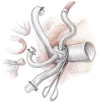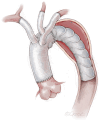T-NEXT graft: step by step operative technique
- PMID: 41098995
- PMCID: PMC12519268
- DOI: 10.21037/acs-2025-evet-26
T-NEXT graft: step by step operative technique
Abstract
The frozen elephant trunk (FET) technique has become a cornerstone in the management of complex aortic arch disease, yet reinterventions, both proximally on the root and distally on the thoracoabdominal aorta, remain common. Conventional FET prostheses were designed to recreate standard arch anatomy with the distal anastomosis beyond the left subclavian artery (LSA) and the supra-aortic branches in proximal-to-distal sequence. However, the current trend towards more proximal anastomosis in zones 0-2, brings the arch branches closer to the aortic root, which can limit root access during reoperation by reducing the available clamping zone, and also creates unfavorable angulations for antegrade visceral vessel cannulation during distal endovascular repair. Here, we describe the step-by-step operative technique for a new graft, the T-NEXT, a customized modification of the Thoraflex hybrid prosthesis, designed for improved life-time management of complex aortic disease, featuring a transverse and distal alignment of the arch branches. This configuration leaves an unobstructed proximal graft segment to facilitate safe distal clamping in future proximal reoperations, while preserving a smooth, bidirectional pathway for antegrade and retrograde endovascular access.
Keywords: Frozen elephant trunk (FET); T-NEXT graft; total arch replacement.
Copyright © 2025 AME Publishing Company. All rights reserved.
Conflict of interest statement
Conflicts of Interest: The authors have no conflicts of interest to declare.
Figures










References
Publication types
LinkOut - more resources
Full Text Sources
